Urban Network Spatial Connection and Structure in China Based on Railway Passenger Flow Big Data
Abstract
:1. Introduction
1.1. Progress in the “Flow Space” Theory
1.2. Progress in the Spatial Interaction Model
1.3. Progress in Accessibility Methods
2. Materials and Methods
2.1. Materials
2.2. Methods
2.2.1. Weighted Average Travel Time
2.2.2. Railway Network Density
2.2.3. Economic Connection Model
3. Results
3.1. Spatiotemporal Distribution Pattern of the Urban Network
3.1.1. Railway Network Accessibility in China
3.1.2. Connectivity of the Railway Network in China
3.2. Spatial Interaction Distribution Pattern of Urban Network
3.2.1. Spatial Distribution Pattern of Total Economic Connection in China
3.2.2. Spatial Distribution of the Top 50 Cities Ranked by Interurban Economic Connection
4. Discussion
4.1. Spatial Connection and Structure of Urban Agglomerations
4.2. Characteristics of Spatial Connection Pattern and Sustainable Development
4.3. Contributions and Future Improvements
5. Conclusions
- (1)
- The accessibility of the railway network presents strip distribution characteristics and reflects significant differences between east and west, and the accessibility of the railway network in the eastern region is higher than that in the western region. The accessibility of national-level urban agglomerations is greater than that of regional-level urban agglomerations, and far greater than that of local-level urban agglomerations.
- (2)
- The railway network density presents regional differences. The railway network density in the eastern region is much greater than that in the western region. Areas with large railway network density are mainly concentrated in the urban agglomerations of Beijing-Tianjin-Hebei, Central Plains, Yangtze River Delta, Jianghuai, and the Triangle of Central China. There is some mismatch between China’s railway network layout and population and urban layout. We must strengthen the railway network construction in central and eastern regions with large population densities, especially the Beijing-Tianjin-Hebei, Yangtze River Delta, and other key urban agglomerations.
- (3)
- The total external economic connection in China shows a decreasing trend from the east to the west, as the eastern region is significantly higher than the central region, and much higher than the western region. The total economic connection of national-level urban agglomerations is greater than that of regional-level urban agglomerations, and far greater than that of local-level urban agglomerations. The Pearl River Delta urban agglomeration had the highest total economic connection. The top 50 cities ranked by interurban economic connection showed a “diamond shape” distribution. The four diamond-shaped pairs were Beijing-Tianjin-Hebei, Yangtze River Delta, Pearl River Delta, and Chengyu urban agglomerations.
Author Contributions
Funding
Institutional Review Board Statement
Informed Consent Statement
Data Availability Statement
Acknowledgments
Conflicts of Interest
References
- Lu, D. About the “14th Five-Year Plan”: Fields and Understanding. Sci. Geogr. Sin. 2020, 40, 1–5. [Google Scholar]
- Ministry of Transport of the People’s Republic of China. Statistical Bulletin on the Development of the Transportation Industry 2020. Available online: https://xxgk.mot.gov.cn/2020/jigou/zhghs/202105/t20210517_3593412.html (accessed on 17 November 2021).
- Ministry of Transport of the People’s Republic of China. The Central Committee of the Communist Party of China and the State Council issued the “National Comprehensive Three-dimensional Transportation Network Planning Outline”. Available online: http://www.mot.gov.cn/2021zhengcejd/zongheltjtwghtj/xiangguanzhengce/202102/t20210225_3527771.html (accessed on 17 November 2021).
- Li, M.; Guo, R.; Li, Y.; He, B.; Chen, Y.; Fan, Y. Distribution characteristics of the transportation network in China at the county level. IEEE Access 2019, 7, 49251–49261. [Google Scholar] [CrossRef]
- Li, M.; Guo, R.; Li, Y.; He, B.; Fan, Y. The Distribution Pattern of the Railway Network in China at the County Level. ISPRS Int. J. Geo-Inf. 2019, 8, 336. [Google Scholar] [CrossRef] [Green Version]
- Li, M. The Study on Spatial Structure Evolution of Three Major Urban Agglomerations in China; Jilin University Press: Changchun, China, 2018. [Google Scholar]
- Castells, M. The Informational City: Information Technology, Economic Restructuring, and the Urban-Regional Process; Basil Blackwell: Oxford, UK, 1989. [Google Scholar]
- Castells, M. End of Millennium: The Information Age: Economy, Society and Culture; Basil Blackwell: Oxford, UK, 1998. [Google Scholar]
- Parnham, R. To What Extent Has Research Conducted by the GaWC Research Network Aided Our Understanding of Large EU Law Firm Geography? University of Westminster: London, UK, 2016. [Google Scholar]
- Yarwood, J.; Egeraat, C.; Sokol, M. POLYNET Action 1.1: Commuting and the Definition of Functional Urban Regions, Greater Dublin; Pulmonary function testing: Saunders, UK, 2005. [Google Scholar]
- Zhang, X.; Li, Z.; Change Loy, C.; Lin, D. Polynet: A pursuit of structural diversity in very deep networks. In Proceedings of the IEEE Conference on Computer Vision and Pattern Recognition (CVPR), Honolulu, HI, USA, 21–26 July 2017; pp. 718–726. [Google Scholar]
- Yin, P.; Lin, Z.; Prideaux, B. The impact of high-speed railway on tourism spatial structures between two adjoining metropolitan cities in China: Beijing and Tianjin. J. Transp. Geogr. 2019, 80, 102495. [Google Scholar] [CrossRef] [PubMed]
- Louail, T.; Lenormand, M.; Picornell, M.; Barthelemy, M. Uncovering the spatial structure of mobility networks. Nat. Commun. 2015, 6, 6007. [Google Scholar] [CrossRef] [Green Version]
- Rodrigue, J.P.; Comtois, C.; Slack, B. The Geography of Transport Systems; Routledge: New York, NY, USA, 2009. [Google Scholar]
- Thompson, C.A.; Saxberg, K.; Lega, J.; Tong, D.; Brown, H.E. A cumulative gravity model for inter-urban spatial interaction at different scales. J. Transp. Geogr. 2019, 79, 102461. [Google Scholar] [CrossRef]
- Yan, X.Y.; Zhou, T. Destination choice game: A spatial interaction theory on human mobility. Sci. Rep. 2019, 9, 9466. [Google Scholar] [CrossRef]
- Rong, P.; Zheng, Z.; Kwan, M.P.; Qin, Y. Evaluation of the spatial equity of medical facilities based on improved potential model and map service API: A case study in Zhengzhou, China. Appl. Geogr. 2020, 119, 102192. [Google Scholar] [CrossRef]
- Griffith, D.A. Spatial Autocorrelation in Spatial Interaction; Springer: Berlin, Germany, 2009. [Google Scholar]
- Reilly, W.J. Methods for the Study of Retail Relationships; University of Texas: Austin, TX, USA, 1929. [Google Scholar]
- Converse, P.D. New laws of retail gravitation. J. Mark. 1949, 14, 379–384. [Google Scholar] [CrossRef]
- Wilson, A.G. A statistical theory of spatial distribution models. Transp. Res. 1967, 1, 253–269. [Google Scholar] [CrossRef]
- Guo, D.; Chen, L. Prediction of the Spatial Structure of Cruise Market Based on Spatial Gravity Model—A Case Study of Shanghai Cruise Port. In Proceedings of the 2020 International Conference on Power, Energy, Electrical and Environmental Science, Chengdu, China, 29–30 June 2020. [Google Scholar]
- Yeghikyan, G.; Opolka, F.L.; Nanni, M.; Lepri, B.; Lio, P. Learning Mobility Flows from Urban Features with Spatial Interaction Models and Neural Networks. In Proceedings of the 2020 IEEE International Conference on Smart Computing, Bologna, Italy, 22–25 June 2020. [Google Scholar]
- Hansen, W.G. How accessibility shapes land use. J. Am. Plan. Assoc. 1959, 25, 73–76. [Google Scholar] [CrossRef]
- Morris, J.M.; Dumble, P.L.; Wigan, M.R. Accessibility indicators for transport planning. Transp. Res. Part A Gen. 1979, 13, 91–109. [Google Scholar] [CrossRef]
- Shen, Q. Spatial technologies, accessibility, and the social construction of urban space. Comput. Environ. Urban Syst. 1998, 22, 447–464. [Google Scholar] [CrossRef]
- Stępniak, M.; Rosik, P. The role of transport and population components in change in accessibility: The influence of the distance decay parameter. Netw. Spat. Econ. 2018, 18, 291–312. [Google Scholar] [CrossRef] [Green Version]
- Cascetta, E.; Cartenì, A.; Montanino, M. A behavioral model of accessibility based on the number of available opportunities. J. Transp. Geogr. 2016, 51, 45–58. [Google Scholar] [CrossRef]
- Dou, K.; Zhan, Q. Accessibility analysis of urban emergency shelters: Comparing gravity model and space syntax. In Proceedings of the International Conference on Remote Sensing, Environment and Transportation Engineering, Nanjing, China, 24–26 June 2011. [Google Scholar]
- Stanković, M.; Gladović, P.; Popović, V. Determining the importance of the criteria of traffic accessibility using fuzzy AHP and rough AHP method. Decis. Mak. Appl. Manag. Eng. 2019, 2, 86–104. [Google Scholar] [CrossRef]
- Tannous, H.O.; Major, M.D.; Furlan, R. Accessibility of green spaces in a metropolitan network using space syntax to objectively evaluate the spatial locations of parks and promenades in Doha, State of Qatar. Urban For. Urban Green. 2021, 58, 126892. [Google Scholar] [CrossRef]
- Ministry of Civil Affairs of the People’s Republic of China. Administrative Division of the People’s Republic of China; Chinese Social Publishing House: Beijing, China, 2017.
- National Bureau of Statistics of China. China County Statistical Yearbook; China Statistics Press: Beijing, China, 2017.
- National Bureau of Statistics of China. China City Statistical Yearbook-2017; China Statistics Press: Beijing, China, 2017.
- Cao, K.; Diao, M.; Wu, B. A big data–based geographically weighted regression model for public housing prices: A case study in Singapore. Ann. Am. Assoc. Geogr. 2019, 109, 173–186. [Google Scholar] [CrossRef]
- Vieira, R.S.; Haddad, E.A. A weighted travel time index based on data from Uber Movement. EPJ Data Sci. 2020, 9, 24. [Google Scholar] [CrossRef]
- Yan, W.Y.; Wang, F.Z.; Qin, Y.C. Analysis of the principle and evolvement of the theoretic models of urban spatial interaction. Prog. Geogr. 2009, 28, 511–518. [Google Scholar]
- Li, M.; He, B.; Guo, R.; Li, Y.; Chen, Y.; Fan, Y. Study on population distribution pattern at the county level of China. Sustainability 2018, 10, 3598. [Google Scholar] [CrossRef] [Green Version]
- Zhang, C.; Li, M.; Ma, D.; Guo, R. How Different are Population Movements between Weekdays and Weekends: A Complex-Network-Based Analysis on 36 Major Chinese Cities. Land 2021, 10, 1160. [Google Scholar] [CrossRef]
- Yao, S.M. Urban Agglomerations of China; University of Science and Technology of China Press: Hefei, China, 2006. [Google Scholar]
- Gu, C.L.; Yu, T.F.; Li, W.M. Urbanization in China: Pattern, Process and Mechanism; Science Press: Beijing, China, 2008. [Google Scholar]
- Fang, C.L.; Bao, C.; Ma, H.T. Urban Agglomeration Development in China; Science Press: Beijing, China, 2016. [Google Scholar]
- Fan, J.; Li, P. The scientific foundation of major function oriented zoning in China. J. Geogr. Sci. 2009, 19, 515–531. [Google Scholar] [CrossRef]
- Wang, G.T. National Urban System Planning 2006–2020; The Commercial Press: Beijing, China, 2010. [Google Scholar]
- United Nations. Sustainable Transport. Available online: https://sustainabledevelopment.un.org/topics/sustainabletransport (accessed on 17 November 2021).
- Pan, J.; Lai, J. Spatial pattern of population mobility among cities in China: Case study of the National Day plus Mid-Autumn Festival based on Tencent migration data. Cities 2019, 94, 55–69. [Google Scholar] [CrossRef]
- Gibbs, H.; Liu, Y.; Pearson, C.A.; Eggo, R.M. Changing travel patterns in China during the early stages of the COVID-19 pandemic. Nat. Commun. 2020, 11, 5012. [Google Scholar] [CrossRef]
- Bengtsson, L.; Gaudart, J.; Lu, X.; Piarroux, R. Using mobile phone data to predict the spatial spread of cholera. Sci. Rep. 2015, 5, 8923. [Google Scholar] [CrossRef]
- Lee, K.S.; You, S.Y.; Eom, J.K.; Song, J.; Min, J.H. Urban spatiotemporal analysis using mobile phone data: Case study of medium-and large-sized Korean cities. Habitat Int. 2018, 73, 6–15. [Google Scholar] [CrossRef]
- Gariazzo, C.; Pelliccioni, A. A multi-city urban population mobility study using mobile phone traffic data. Appl. Spat. Anal. Policy 2019, 12, 753–771. [Google Scholar] [CrossRef]
- Wei, S.; Wang, L. Examining the population flow network in China and its implications for epidemic control based on Baidu migration data. Humanit. Soc. Sci. Commun. 2020, 7, 145. [Google Scholar] [CrossRef]
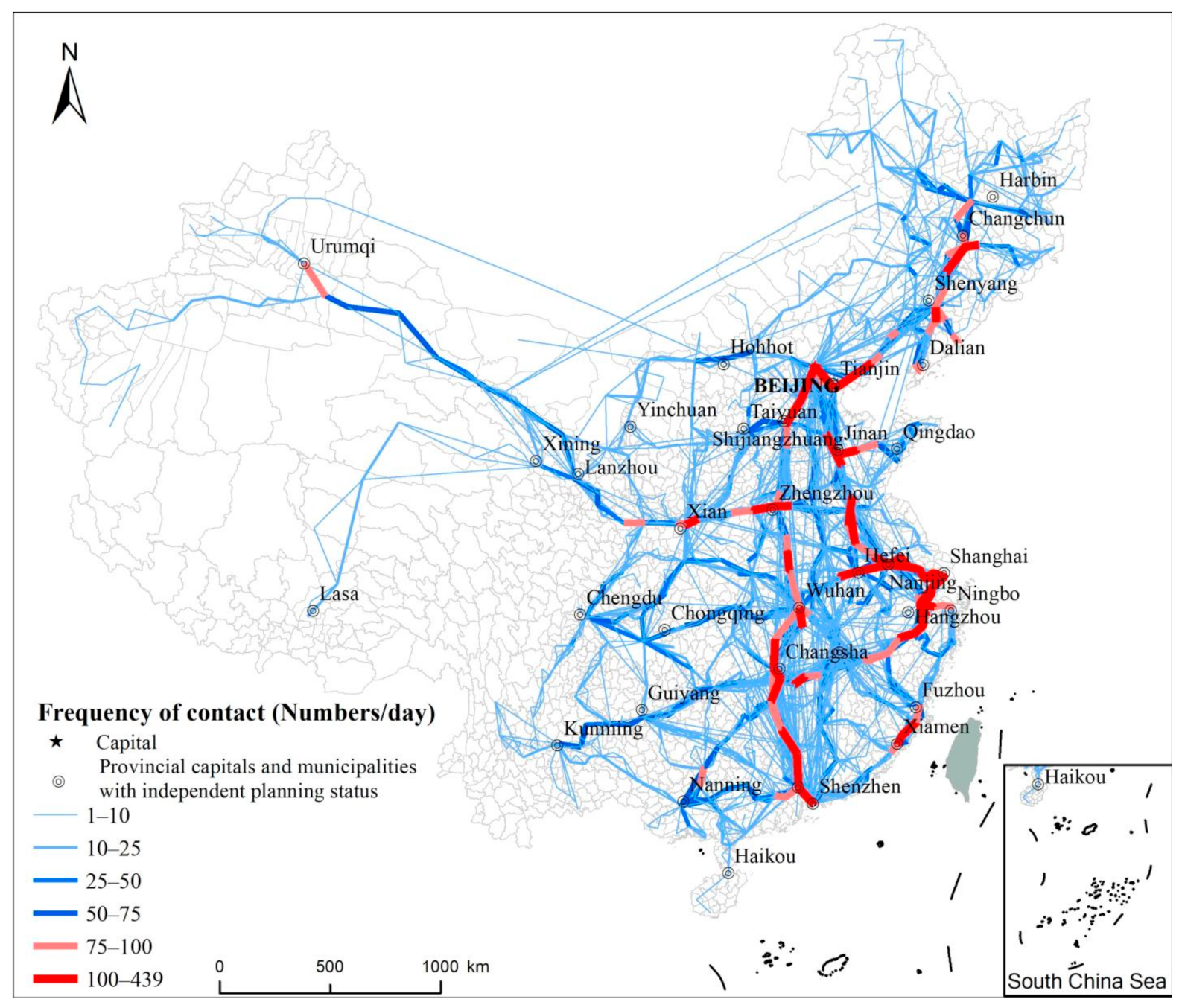
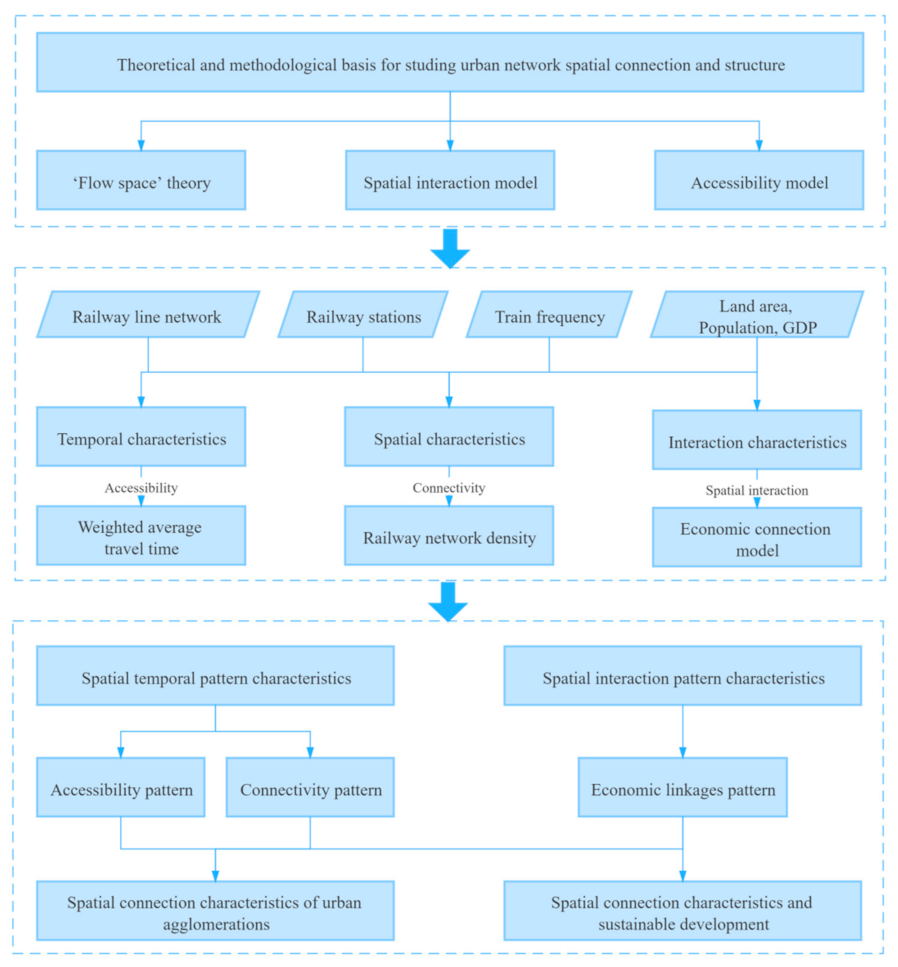
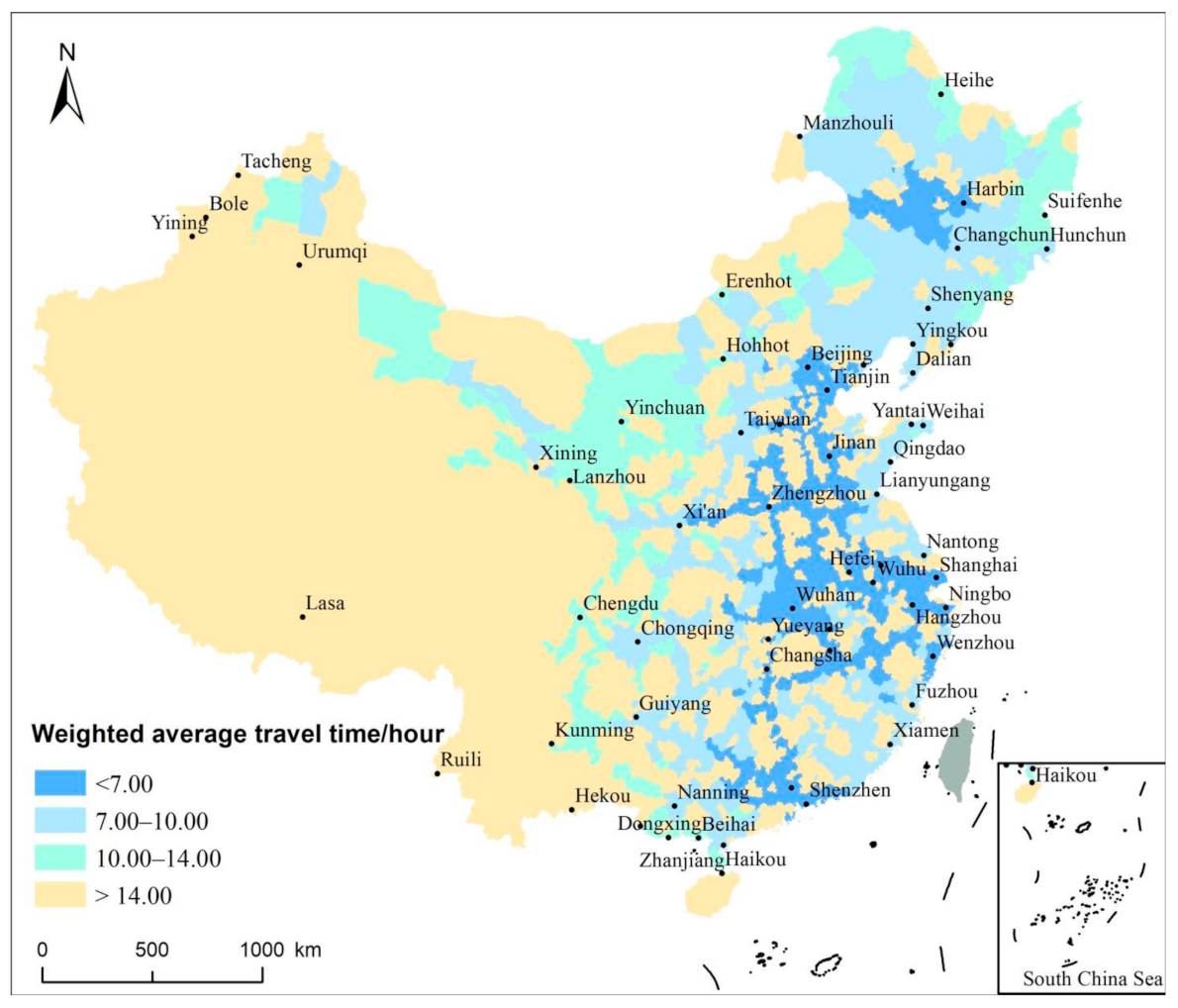



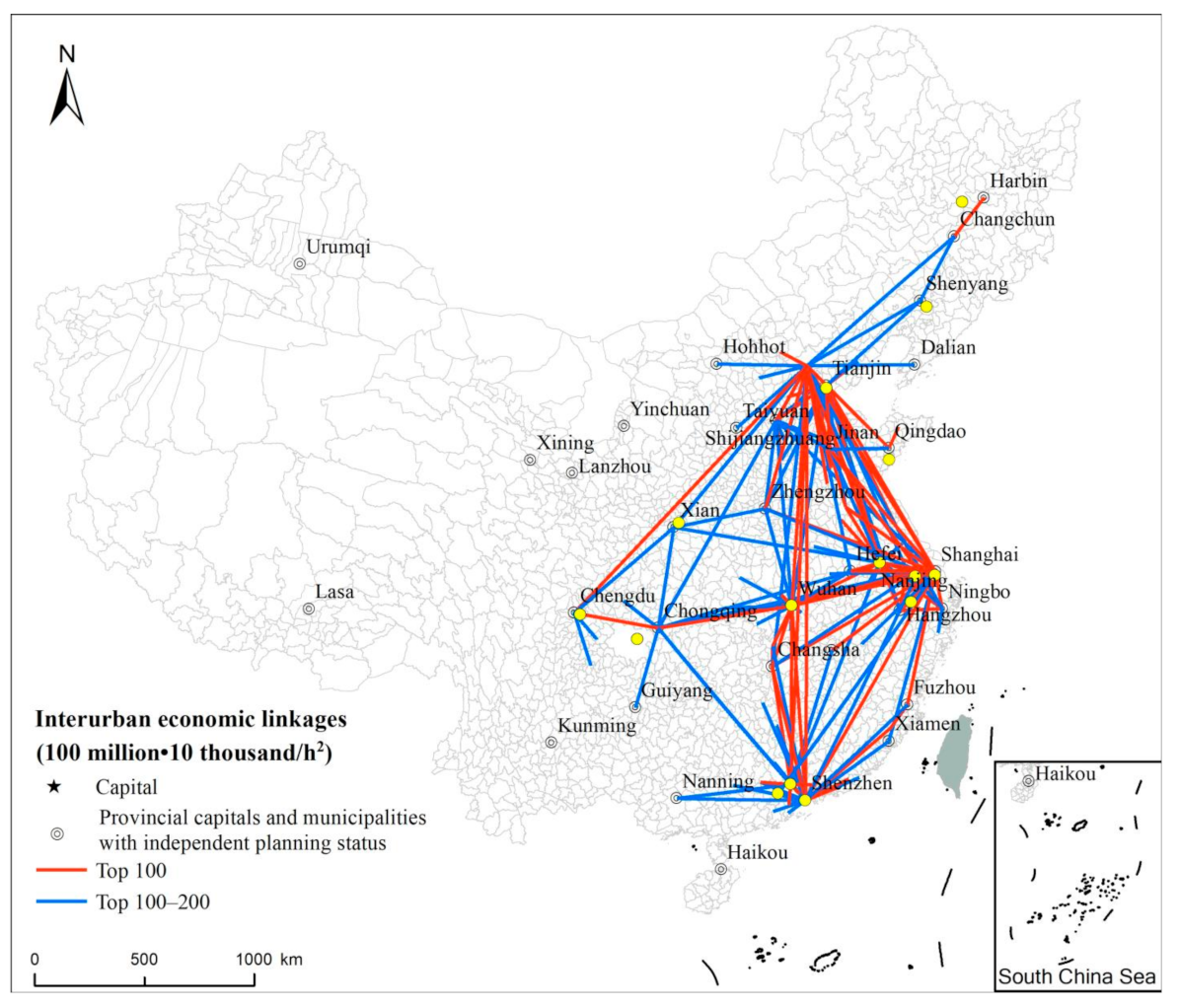
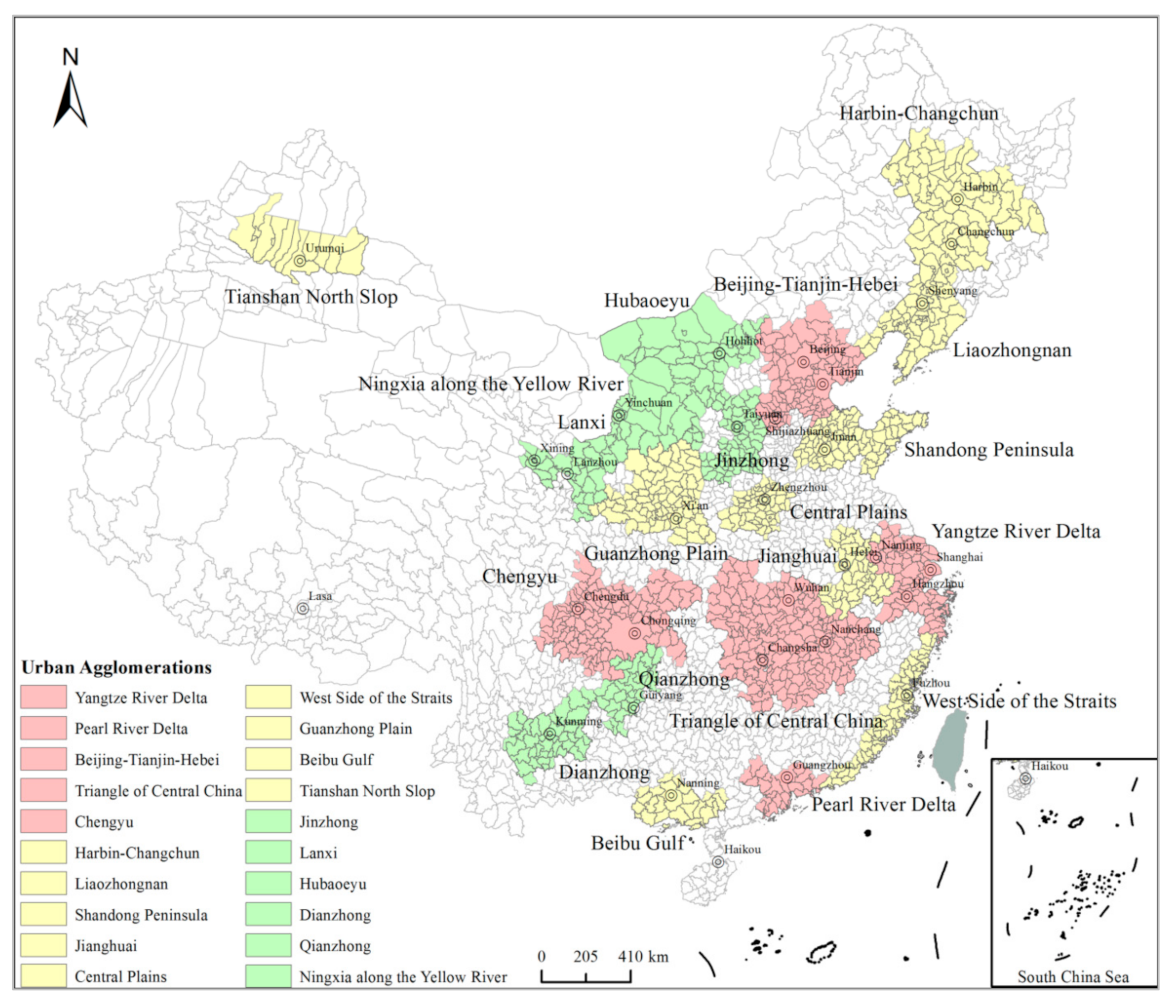
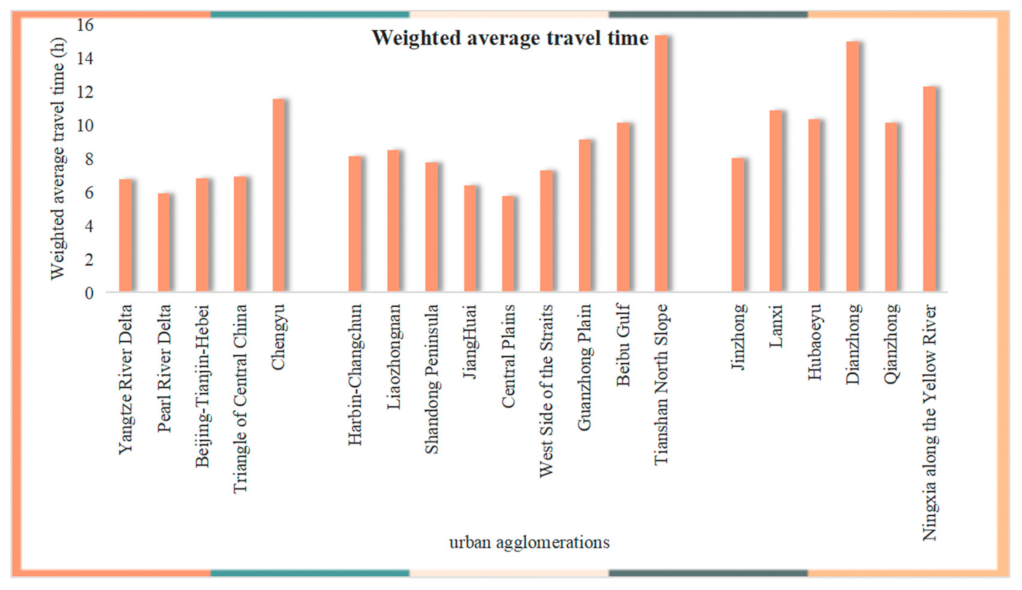
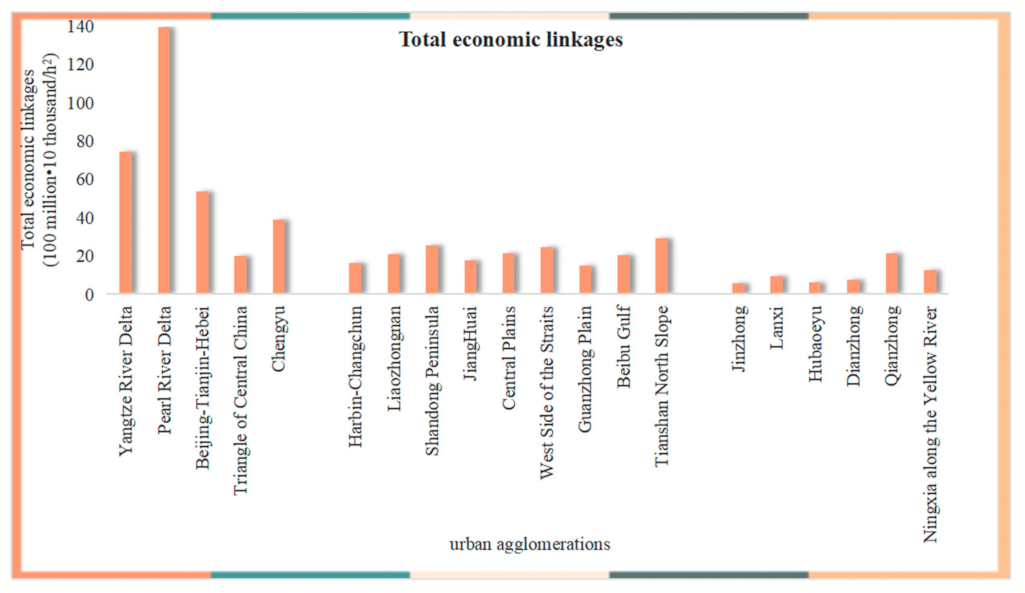
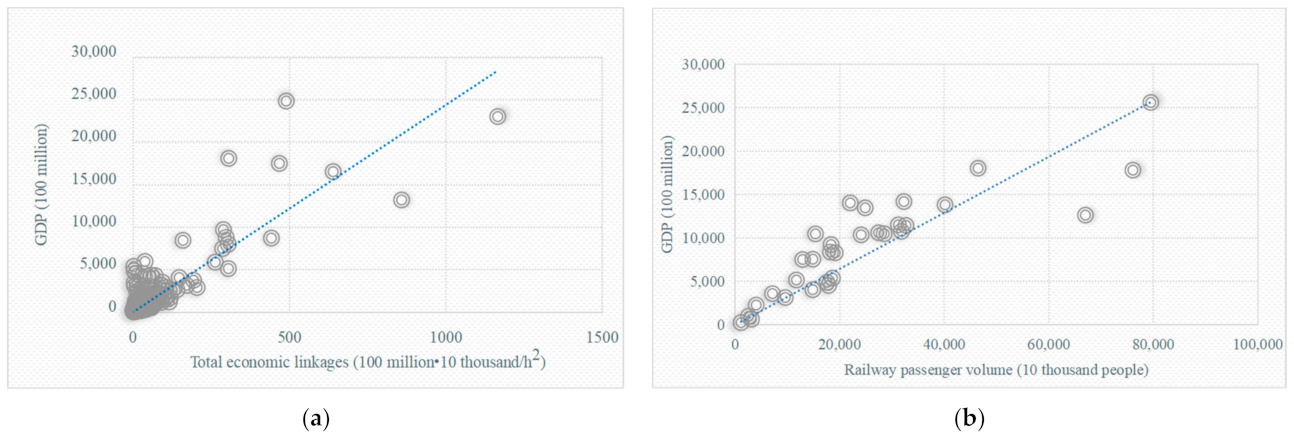
| Name | Time | Source | Method |
|---|---|---|---|
| Land area, Population, GDP | 2016 | China County Statistical Yearbook, China City Statistical Yearbook | Spatial visualization |
| Railway line network, Railway stations, Train frequency | 2016 | AMAP, Railway Customer Service Center of China | Web crawler technology |
Publisher’s Note: MDPI stays neutral with regard to jurisdictional claims in published maps and institutional affiliations. |
© 2022 by the authors. Licensee MDPI, Basel, Switzerland. This article is an open access article distributed under the terms and conditions of the Creative Commons Attribution (CC BY) license (https://creativecommons.org/licenses/by/4.0/).
Share and Cite
Li, M.; Guo, W.; Guo, R.; He, B.; Li, Z.; Li, X.; Liu, W.; Fan, Y. Urban Network Spatial Connection and Structure in China Based on Railway Passenger Flow Big Data. Land 2022, 11, 225. https://doi.org/10.3390/land11020225
Li M, Guo W, Guo R, He B, Li Z, Li X, Liu W, Fan Y. Urban Network Spatial Connection and Structure in China Based on Railway Passenger Flow Big Data. Land. 2022; 11(2):225. https://doi.org/10.3390/land11020225
Chicago/Turabian StyleLi, Minmin, Wenhua Guo, Renzhong Guo, Biao He, Zhichao Li, Xiaoming Li, Wenchao Liu, and Yong Fan. 2022. "Urban Network Spatial Connection and Structure in China Based on Railway Passenger Flow Big Data" Land 11, no. 2: 225. https://doi.org/10.3390/land11020225
APA StyleLi, M., Guo, W., Guo, R., He, B., Li, Z., Li, X., Liu, W., & Fan, Y. (2022). Urban Network Spatial Connection and Structure in China Based on Railway Passenger Flow Big Data. Land, 11(2), 225. https://doi.org/10.3390/land11020225







